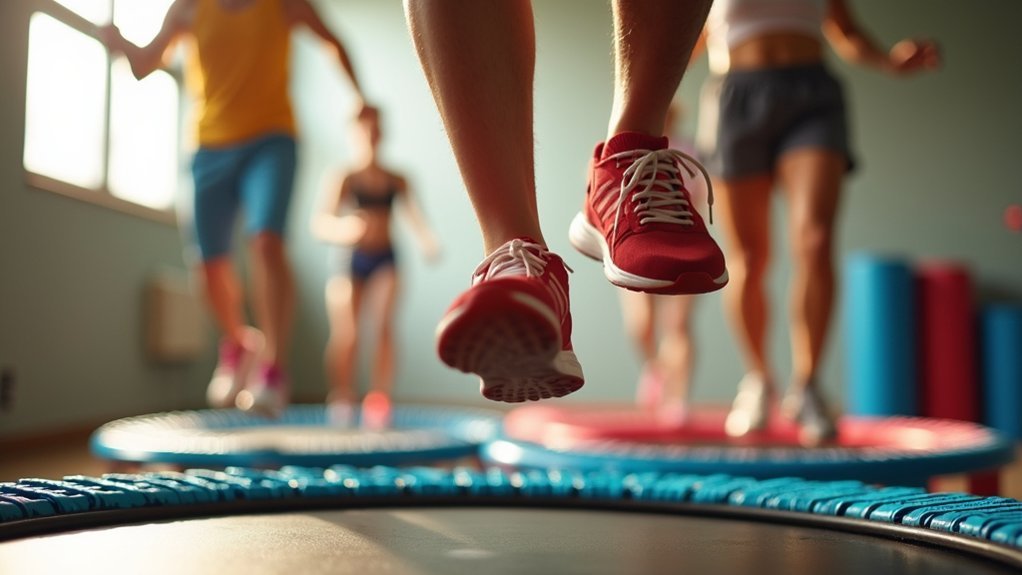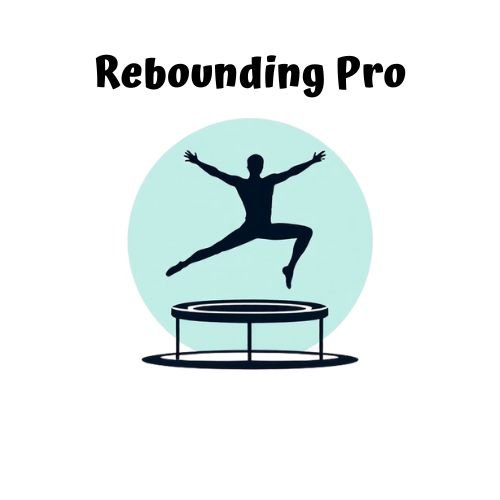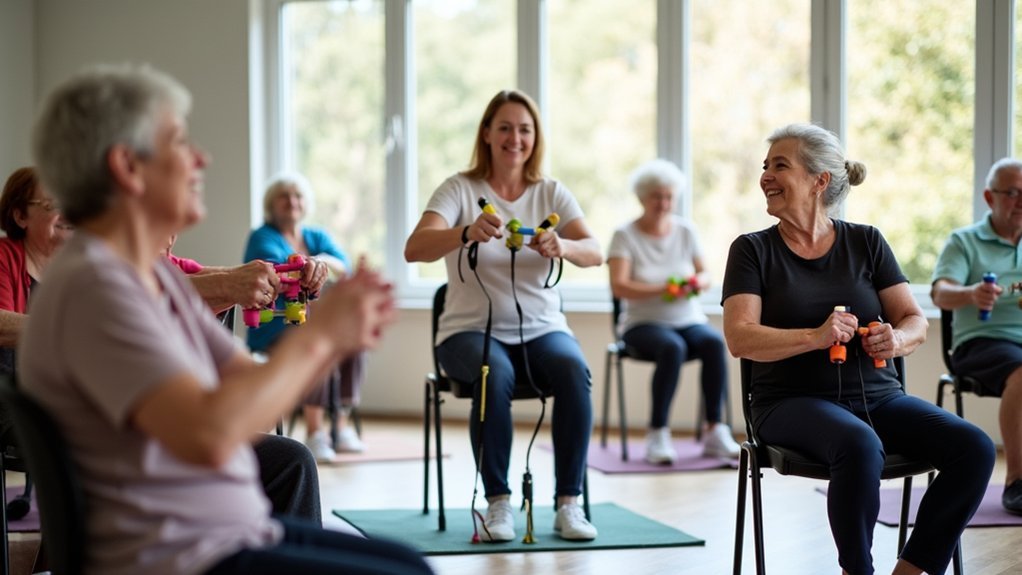Rebounding workouts strengthen your heart in multiple ways. They elevate your heart rate without joint stress, as the trampoline absorbs up to 87% of impact force. You’ll improve oxygen circulation, enhance blood pressure management, and build cardiovascular endurance efficiently—NASA found 10 minutes on a rebounder equals a 30-minute run. Regular sessions flush your lymphatic system, boost immune function, and lower cholesterol. These benefits make rebounding an ideal exercise for all ages and fitness levels.
The Cardio-Boosting Power of Rebounding Exercises

While traditional cardio workouts often focus on running or cycling, rebounding exercises offer a unique approach to heart health that’s both effective and gentle on your joints. Each bounce on a mini-trampoline elevates your heart rate, strengthening your cardiac muscle through rhythmic, repetitive movements.
You’ll experience improved oxygen circulation as rebounding accelerates red blood cell oxygenation throughout your body. This efficient blood pumping mechanism trains your heart to work smarter, not harder, resulting in fewer beats per minute over time.
What’s remarkable is that rebounding delivers cardio benefits comparable to running or cycling, but without the harsh impact. The unstable surface engages your entire muscular system, optimizing oxygen utilization and boosting your VO2 max through sustained aerobic activity. Even just a 2-minute session can significantly increase oxygen supply to tissues while enhancing cardiovascular performance.
How Rebounders Improve Heart Muscle Efficiency
Rebounding doesn’t just elevate your heart rate—it fundamentally transforms how your heart muscle functions. NASA research suggests just 10 minutes on a rebounder delivers cardiovascular benefits equivalent to a 30-minute run, making it remarkably time-efficient for heart health.
Your heart reaches moderate to vigorous intensity levels (76.5 ± 15.5 %HRmax) during rebounding sessions, strengthening cardiac muscle without joint stress. This low-impact exercise improves oxygen efficiency and VO2 max while expanding lung capacity—all essential components of ideal heart function. Studies confirm that regular mini-trampoline training leads to enhanced endurance performance in cardiovascular activities.
The unstable rebounder surface engages core muscles, indirectly supporting cardiac performance. You’ll also experience better lymphatic circulation and stress reduction, both contributing to enhanced heart efficiency.
Unlike high-impact workouts, rebounding allows your cardiovascular system to improve without excessive fatigue or strain.
Lowering Blood Pressure Through Regular Bouncing

Beyond its cardio benefits, regular bouncing on a rebounder offers a natural solution for managing hypertension. The rhythmic movement increases your heart rate while creating a pattern of vascular compression that improves blood flow and reduces peripheral pressure. Rebounding helps separate sticky blood cells, allowing them to move more easily through veins and naturally reducing blood pressure.
| Rebounding Element | Blood Pressure Effect | Recommended Approach |
|---|---|---|
| Frequency | Decreases systolic values | 3-5 sessions weekly |
| Duration | Lowers diastolic pressure | 20-60 minutes per session |
| Intensity | Improves circulation | Start low, increase gradually |
| Consistency | Shortens abnormal BP periods | Maintain regular schedule |
| Hydration | Supports overall BP regulation | Drink water before/after |
You’ll maximize these benefits by gradually increasing your bouncing time while staying properly hydrated. The low-impact nature makes rebounding accessible regardless of your fitness level, allowing you to maintain consistency—key for lasting blood pressure improvements.
Building Cardiovascular Endurance Without Joint Stress
You’ll find rebounding offers an ideal way to strengthen your heart while sparing your joints from high-impact stress.
The trampoline’s springy surface absorbs up to 87% of impact force, allowing you to build cardiovascular endurance through sustained bouncing sessions without risking joint damage.
This gentle yet effective cardio alternative lets you gradually increase your stamina while maintaining proper form and control throughout your workout. Starting with a basic bounce and advancing to variations like scissor movements and jumping jacks creates a full cardiovascular routine that’s accessible for beginners and seasoned exercisers alike.
Low-Impact Heart Training
While many high-intensity workouts can strain your joints over time, low-impact heart training offers a gentler approach to cardiovascular fitness. Rebounders provide the perfect platform for this type of exercise, allowing you to boost your aerobic capacity without the joint stress associated with running or jumping on hard surfaces. Similar to the benefits of low-impact cardio circuits, rebounder workouts are suitable for individuals with knee or hip issues.
| Exercise Type | Heart Benefits |
|---|---|
| Gentle bouncing | Increases blood circulation |
| Interval rebounds | Enhances aerobic capacity |
| Figure-eight movements | Strengthens heart muscles |
| Seated bounces | Reduces cardiovascular disease risk |
| Rebounder jogging | Improves overall heart health |
You’ll still achieve your cardio goals while protecting your knees, hips, and ankles. By monitoring your heart rate during sessions and maintaining consistency with 30-minute workouts, you’ll develop impressive cardiovascular endurance that supports long-term health without the wear and tear.
Gentle Cardio Alternative
For those seeking a gentler approach to cardiovascular training, rebounding serves as an ideal cardio alternative that doesn’t sacrifice effectiveness.
You’ll enjoy significant heart health benefits without the joint stress associated with high-impact exercises.
Despite its low-impact nature, rebounding raises your heart rate within suitable cardio ranges, improving cardiac function and endurance.
Your lungs benefit too, with increased capacity supporting better oxygen circulation throughout your body.
The cushioned surface protects your joints while you burn approximately 9.4 calories per minute—comparable to other moderate cardio activities.
This efficiency makes rebounding sustainable for long-term fitness goals.
Best of all, you can easily adapt workouts to your fitness level, starting gently and progressively increasing intensity as your endurance builds.
Incorporating basic bounce movements helps initiate proper form while gradually increasing your heart rate at the beginning of your trampoline workout session.
Joint-Friendly Stamina Building
Building cardiovascular endurance traditionally comes with a price—joint strain that can sideline even the most dedicated fitness enthusiasts. Rebounders change this equation by allowing you to strengthen your heart without sacrificing your joints.
Your body experiences:
- Progressive cardiovascular adaptation as you gradually increase from 10-minute sessions to full 30-minute routines without the cumulative joint microtrauma of traditional cardio.
- Enhanced stroke volume and VO₂ max development through sustained bouncing that maintains 79% of maximum heart rate.
- Improved stamina through interval training by alternating recovery and effort phases while the rebounder absorbs impact forces. The workout’s integration of jump sequences with basic bounces creates effective cardio intervals that challenge the heart while remaining accessible.
- Consistent training potential without requiring typical joint recovery periods, allowing more frequent cardio sessions that build endurance faster.
Enhanced Oxygen Circulation Benefits for Heart Health
Your mini-trampoline workouts greatly enhance cellular respiration by delivering more oxygen to your body’s cells.
As you bounce, you’ll increase your hemoglobin capacity, allowing your blood to carry more oxygen throughout your system. Rebounding promotes increased red blood cells which significantly improves your body’s ability to transport oxygen.
This oxygen-rich environment helps your heart work more efficiently while fueling cellular energy production for improved overall cardiovascular health.
Boosted Cellular Respiration
While many exercise benefits remain invisible to the naked eye, rebounding’s impact on cellular respiration fundamentally transforms your heart health at the microscopic level.
Each bounce on your rebounder triggers enhanced oxygen delivery to tissues throughout your body, including your heart muscle.
Your cells quite literally breathe easier when you rebound regularly:
- Mitochondrial multiplication – Your cells develop more energy-producing powerhouses, enabling your heart to work more efficiently with less strain.
- Reduced oxidative stress – Better oxygen circulation decreases harmful free radicals that damage heart tissue.
- Optimized energy production – Your heart muscles convert oxygen to energy more effectively, improving overall cardiovascular function.
- Enhanced cellular efficiency – Your heart requires less effort to maintain the same output, reducing long-term cardiovascular strain.
The high-intensity intervals of rebounding workouts significantly increase your V02 Max measurement, which directly correlates with better heart health and longevity.
Hemoglobin Capacity Increases
As you consistently rebound, your body naturally increases its hemoglobin capacity, creating a powerful oxygen circulation system that directly benefits your heart. This enhanced oxygen delivery reduces inflammation and oxidative stress throughout your cardiovascular system.
Your rebounding routine elevates oxygen levels in tissues while encouraging the formation of new capillaries, which greatly improves blood distribution efficiency. Studies have shown that rebounding is 1.5x more efficient than traditional exercises like running or cycling for cardiovascular benefits.
With each bounce, your heart muscle strengthens and adapts to manage increased blood flow, potentially lowering your blood pressure over time.
The improved hemoglobin efficiency supports better tissue oxygenation, essential for maintaining ideal heart function.
You’ll notice increased exercise tolerance and muscular endurance as your body adapts. This systemic oxygenation improvement provides long-term cardiovascular protection while preparing your heart for more challenging high-intensity workouts.
Rebounding’s Role in Strengthening the Lymphatic System

The lymphatic system, often overlooked in discussions about fitness, plays an essential role in maintaining overall health and immunity. When you bounce on a rebounder, the gravitational forces create a pump-like effect that markedly enhances lymph flow throughout your body.
- Detoxification: Just two minutes of rebounding flushes your entire lymphatic system, removing toxins and waste that would otherwise stagnate in your cells.
- Immune Boost: Your white blood cell count increases during rebounding, strengthening your body’s natural defense system.
- Reduced Congestion: If you suffer from lymphedema or swelling, the gentle bouncing motion helps open lymphatic valves to improve fluid movement.
- Anti-Aging Effects: Better cellular cleansing can slow down aging processes by efficiently removing metabolic waste.
Unlike traditional exercises, rebounding provides significant benefits through the up-and-down motion that creates optimal conditions for lymphatic drainage and circulation.
Sustainable Heart Health: Why Rebounders Work for All Ages
Unlike traditional cardio equipment that often excludes certain age groups, rebounders offer remarkable cardiovascular benefits accessible to nearly everyone from children to seniors.
The adjustable intensity allows you to start with gentle bounces and progress as your fitness improves.
Your body experiences multiple cardiovascular advantages with each bounce: strengthened heart muscle, reduced resting heart rate, and improved blood pressure.
Every bounce strengthens your heart, lowers your resting pulse, and helps normalize blood pressure naturally.
Research shows that regular rebounding helps lower cholesterol and triglycerides, contributing to long-term heart health.
The low-impact nature protects your joints while still delivering effective cardiovascular conditioning.
As you age, rebounding continues working for you by improving balance through vestibular stimulation and supporting hormone regulation that impacts heart health.
You’ll maintain bone density while simultaneously training your cardiovascular system—a dual benefit that becomes increasingly valuable with age.
This adaptability guarantees you can sustain heart-healthy exercise throughout life’s changes.
Frequently Asked Questions
How Long Does It Take to See Heart Health Improvements?
You’ll notice initial heart benefits within 2-3 weeks of regular sessions, with measurable resting heart rate improvements by 6-20 weeks, and significant cardiovascular strength comparable to traditional cardio after 20+ weeks.
Can Rebounding Replace Medications for Heart Conditions?
No, rebounding can’t replace heart medications. While it’s beneficial for your cardiovascular health, you should never stop prescribed medications without your doctor’s supervision and guidance. It’s best as a complementary approach.
Are Mini-Trampolines Safe for People With Existing Heart Problems?
If you have heart problems, mini-trampolines aren’t automatically safe for you. You’ll need your doctor’s approval first. They’ll evaluate your specific condition and may recommend modifications or suggest alternative exercises instead.
Do Rebounders Provide Benefits That Traditional Cardio Exercises Cannot?
Yes, you’ll get unique cardiovascular benefits at lower metabolic cost and joint impact with rebounders. They stimulate lymphatic circulation and provide gravitational conditioning that traditional cardio exercises like running or cycling cannot match.
How Does Rebounding Compare to Swimming for Heart Health?
Both rebounding and swimming strengthen your heart, but they differ in application. You’ll experience less joint impact with rebounding while swimming offers lower heart rates during exercise due to water’s buoyancy effect.
In Summary
You’ve now discovered seven powerful ways rebounding strengthens your heart. By incorporating this low-impact exercise into your routine, you’ll boost cardiovascular health without stressing your joints. Whether you’re looking to lower blood pressure, improve oxygen circulation, or enhance your lymphatic system, rebounding delivers results. Start with just minutes a day, and you’ll be supporting your heart health for years to come.





Leave a Reply